radiator Hyundai Equus 2016 Owner's Manual
[x] Cancel search | Manufacturer: HYUNDAI, Model Year: 2016, Model line: Equus, Model: Hyundai Equus 2016Pages: 477, PDF Size: 16.25 MB
Page 27 of 477
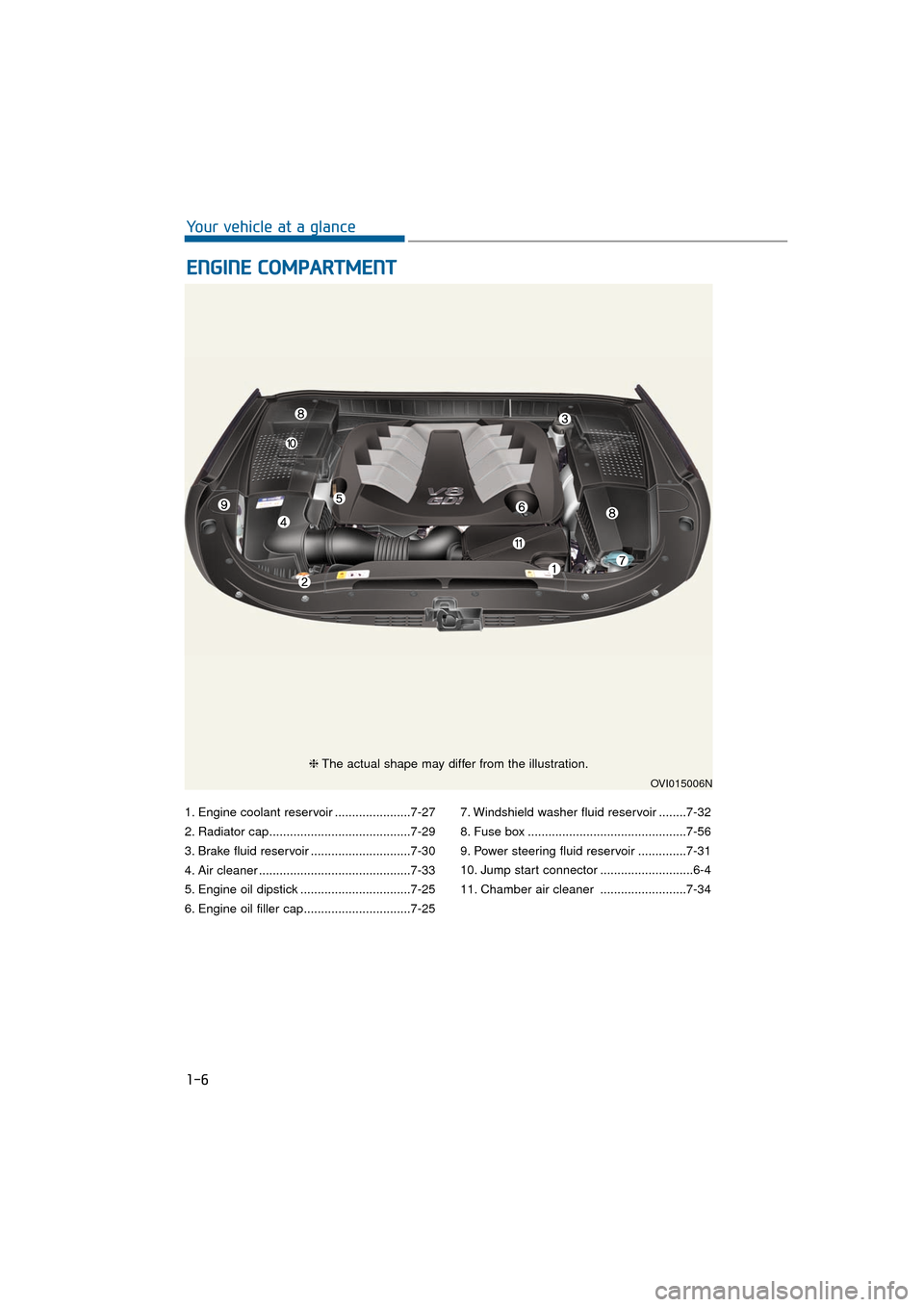
1. Engine coolant reservoir ......................7-27
2. Radiator cap.........................................7-29
3. Brake fluid reservoir .............................7-30
4. Air cleaner ............................................7-33
5. Engine oil dipstick ................................7-25
6. Engine oil filler cap...............................7-257. Windshield washer fluid reservoir ........7-32
8. Fuse box ..............................................7-56
9. Power steering fluid reservoir ..............7-31
10. Jump start connector ...........................6-4
11. Chamber air cleaner .........................7-34
E E
N
N G
GI
IN
N E
E
C
C O
O M
M P
PA
A R
RT
TM
M E
EN
N T
T
1-6
Your vehicle at a glance
OVI015006N
❈ The actual shape may differ from the illustration.
Page 154 of 477
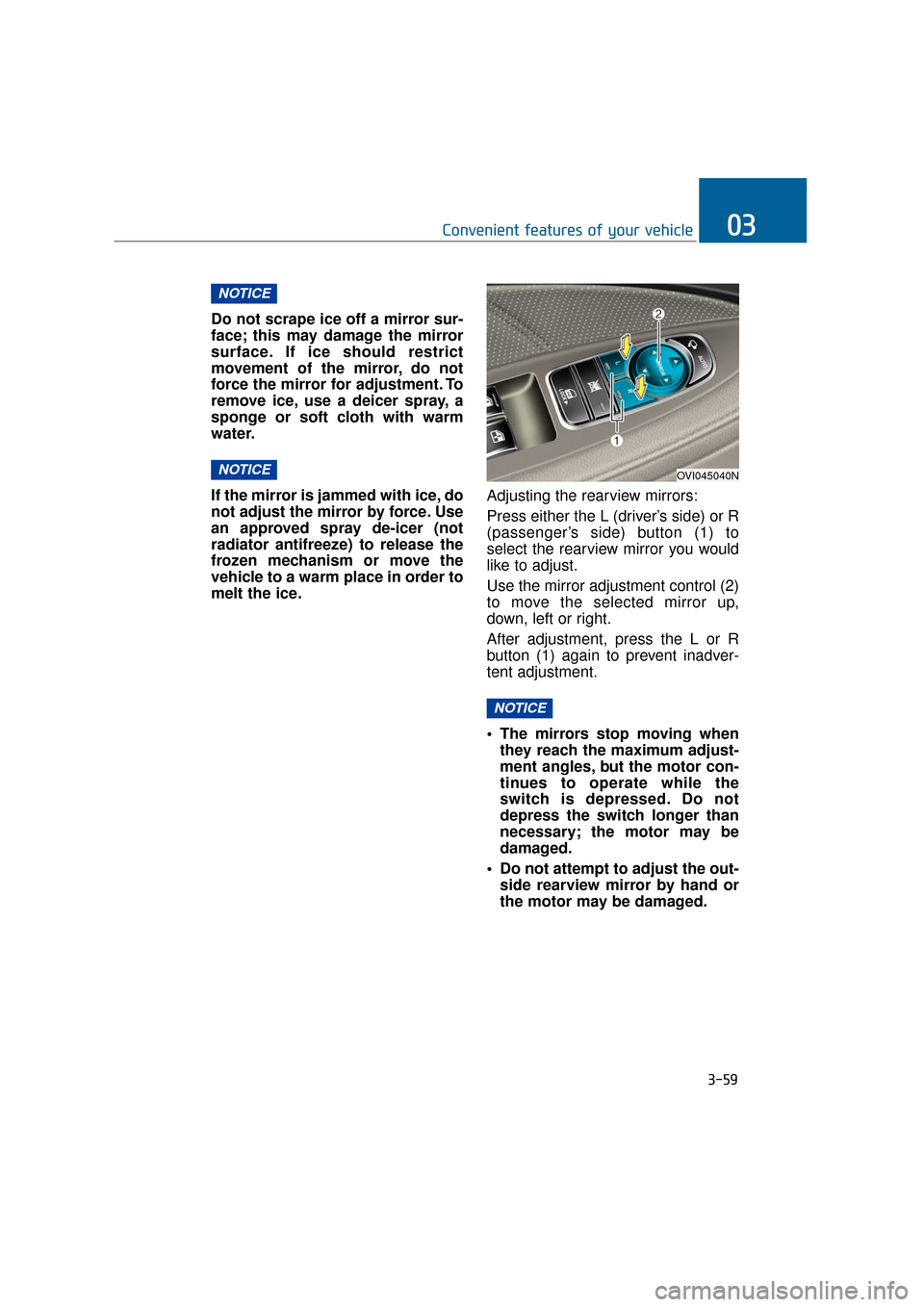
Do not scrape ice off a mirror sur-
face; this may damage the mirror
surface. If ice should restrict
movement of the mirror, do not
force the mirror for adjustment. To
remove ice, use a deicer spray, a
sponge or soft cloth with warm
water.
If the mirror is jammed with ice, do
not adjust the mirror by force. Use
an approved spray de-icer (not
radiator antifreeze) to release the
frozen mechanism or move the
vehicle to a warm place in order to
melt the ice.Adjusting the rearview mirrors:
Press either the L (driver’s side) or R
(passenger’s side) button (1) to
select the rearview mirror you would
like to adjust.
Use the mirror adjustment control (2)
to move the selected mirror up,
down, left or right.
After adjustment, press the L or R
button (1) again to prevent inadver-
tent adjustment.
The mirrors stop moving when
they reach the maximum adjust-
ment angles, but the motor con-
tinues to operate while the
switch is depressed. Do not
depress the switch longer than
necessary; the motor may be
damaged.
Do not attempt to adjust the out- side rearview mirror by hand or
the motor may be damaged.
NOTICE
NOTICE
NOTICE
3-59
Convenient features of your vehicle03
OVI045040N
Page 162 of 477
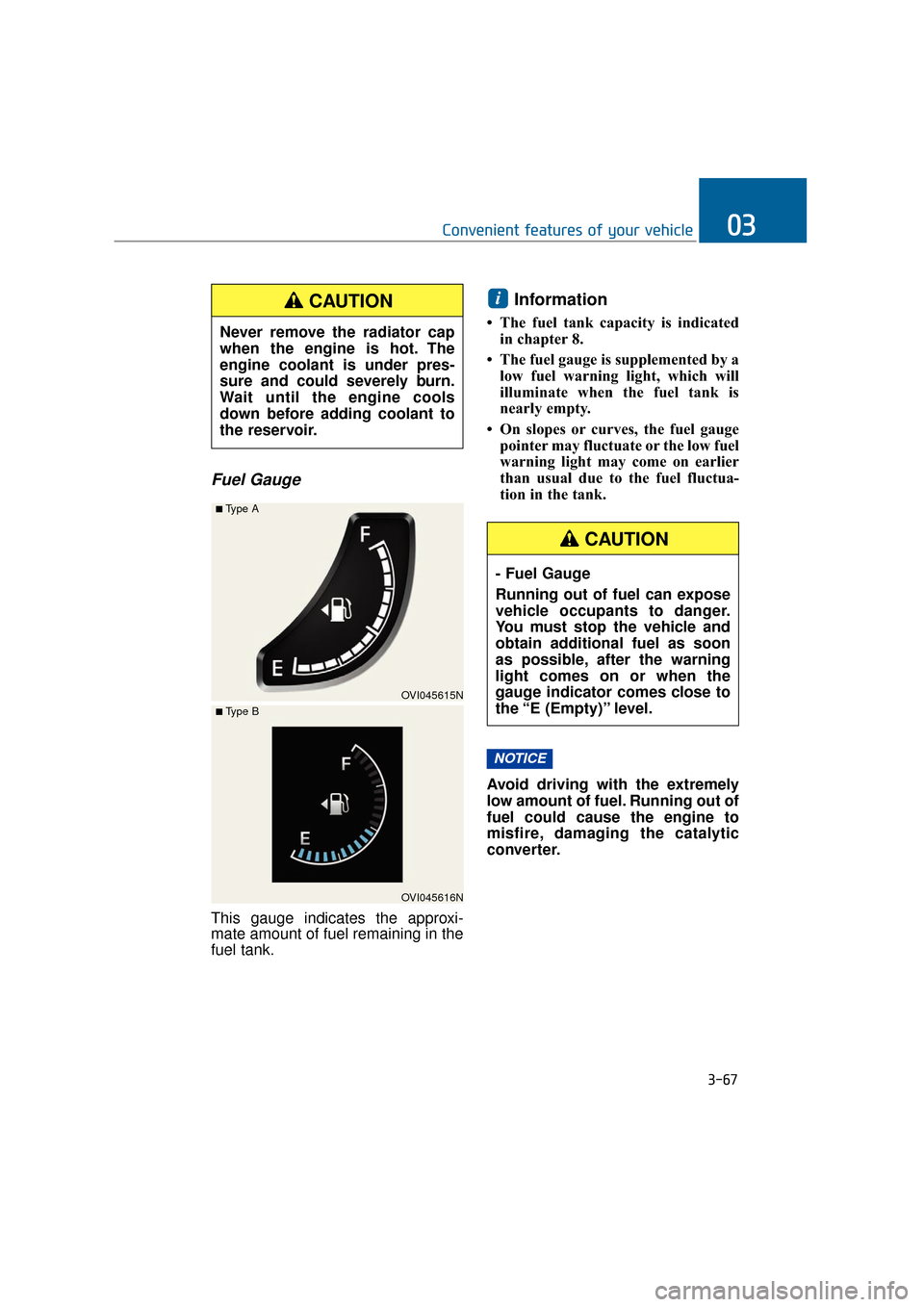
Fuel Gauge
This gauge indicates the approxi-
mate amount of fuel remaining in the
fuel tank.
Information
• The fuel tank capacity is indicatedin chapter 8.
• The fuel gauge is supplemented by a low fuel warning light, which will
illuminate when the fuel tank is
nearly empty.
• On slopes or curves, the fuel gauge pointer may fluctuate or the low fuel
warning light may come on earlier
than usual due to the fuel fluctua-
tion in the tank.
Avoid driving with the extremely
low amount of fuel. Running out of
fuel could cause the engine to
misfire, damaging the catalytic
converter.
NOTICE
i
3-67
Convenient features of your vehicle03
Never remove the radiator cap
when the engine is hot. The
engine coolant is under pres-
sure and could severely burn.
Wait until the engine cools
down before adding coolant to
the reservoir.
CAUTION
OVI045615N
■Type A
OVI045616N
■ Type B
- Fuel Gauge
Running out of fuel can expose
vehicle occupants to danger.
You must stop the vehicle and
obtain additional fuel as soon
as possible, after the warning
light comes on or when the
gauge indicator comes close to
the “E (Empty)” level.
CAUTION
Page 339 of 477
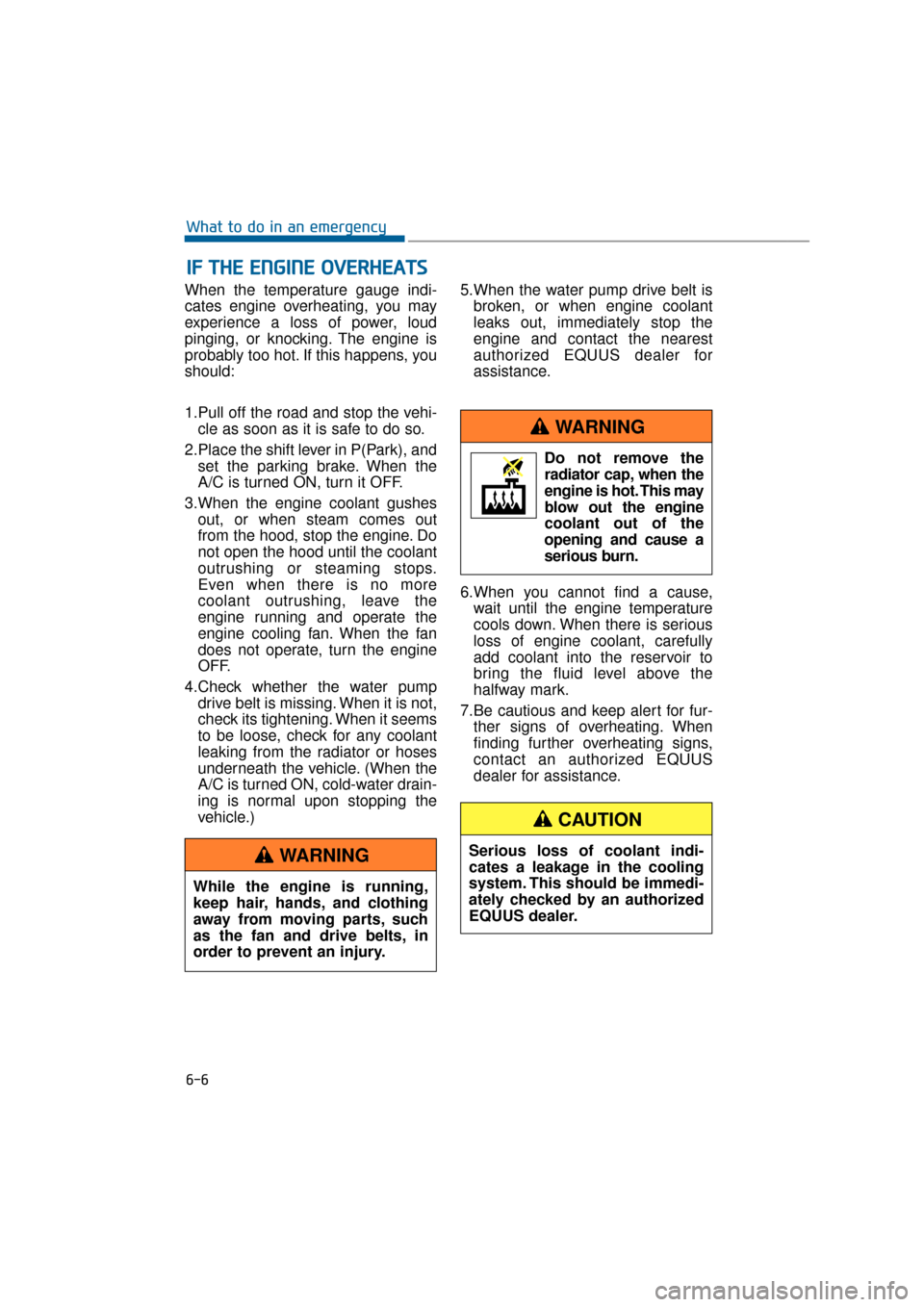
When the temperature gauge indi-
cates engine overheating, you may
experience a loss of power, loud
pinging, or knocking. The engine is
probably too hot. If this happens, you
should:
1.Pull off the road and stop the vehi-cle as soon as it is safe to do so.
2.Place the shift lever in P(Park), and set the parking brake. When the
A/C is turned ON, turn it OFF.
3.When the engine coolant gushes out, or when steam comes out
from the hood, stop the engine. Do
not open the hood until the coolant
outrushing or steaming stops.
Even when there is no more
coolant outrushing, leave the
engine running and operate the
engine cooling fan. When the fan
does not operate, turn the engine
OFF.
4.Check whether the water pump drive belt is missing. When it is not,
check its tightening. When it seems
to be loose, check for any coolant
leaking from the radiator or hoses
underneath the vehicle. (When the
A/C is turned ON, cold-water drain-
ing is normal upon stopping the
vehicle.) 5.When the water pump drive belt is
broken, or when engine coolant
leaks out, immediately stop the
engine and contact the nearest
authorized EQUUS dealer for
assistance.
6.When you cannot find a cause, wait until the engine temperature
cools down. When there is serious
loss of engine coolant, carefully
add coolant into the reservoir to
bring the fluid level above the
halfway mark.
7.Be cautious and keep alert for fur- ther signs of overheating. When
finding further overheating signs,
contact an authorized EQUUS
dealer for assistance.
I IF
F
T
T H
H E
E
E
E N
N G
GI
IN
N E
E
O
O V
VE
ER
R H
H E
EA
A T
TS
S
6-6
What to do in an emergency
While the engine is running,
keep hair, hands, and clothing
away from moving parts, such
as the fan and drive belts, in
order to prevent an injury.
WARNING
Do not remove theradiator cap, when the
engine is hot. This may
blow out the engine
coolant out of the
opening and cause a
serious burn.
WARNING
Serious loss of coolant indi-
cates a leakage in the cooling
system. This should be immedi-
ately checked by an authorized
EQUUS dealer.
CAUTION
Page 361 of 477
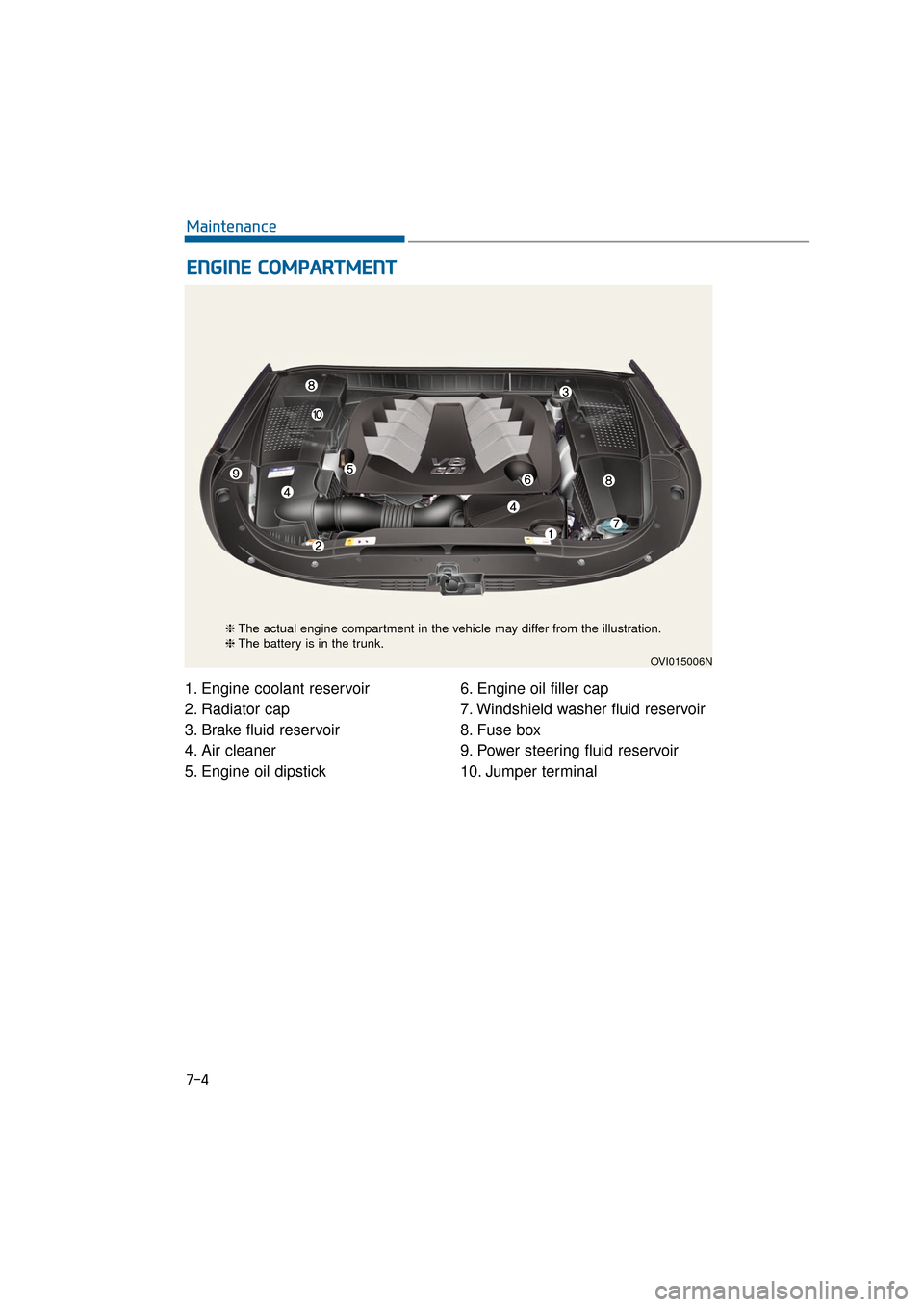
1. Engine coolant reservoir
2. Radiator cap
3. Brake fluid reservoir
4. Air cleaner
5. Engine oil dipstick6. Engine oil filler cap
7. Windshield washer fluid reservoir
8. Fuse box
9. Power steering fluid reservoir
10. Jumper terminal
E E
N
N G
GI
IN
N E
E
C
C O
O M
M P
PA
A R
RT
TM
M E
EN
N T
T
7-4
OVI015006N
Maintenance
❈ The actual engine compartment in the vehicle may differ from the illustration.
❈ The battery is in the trunk.
Page 365 of 477
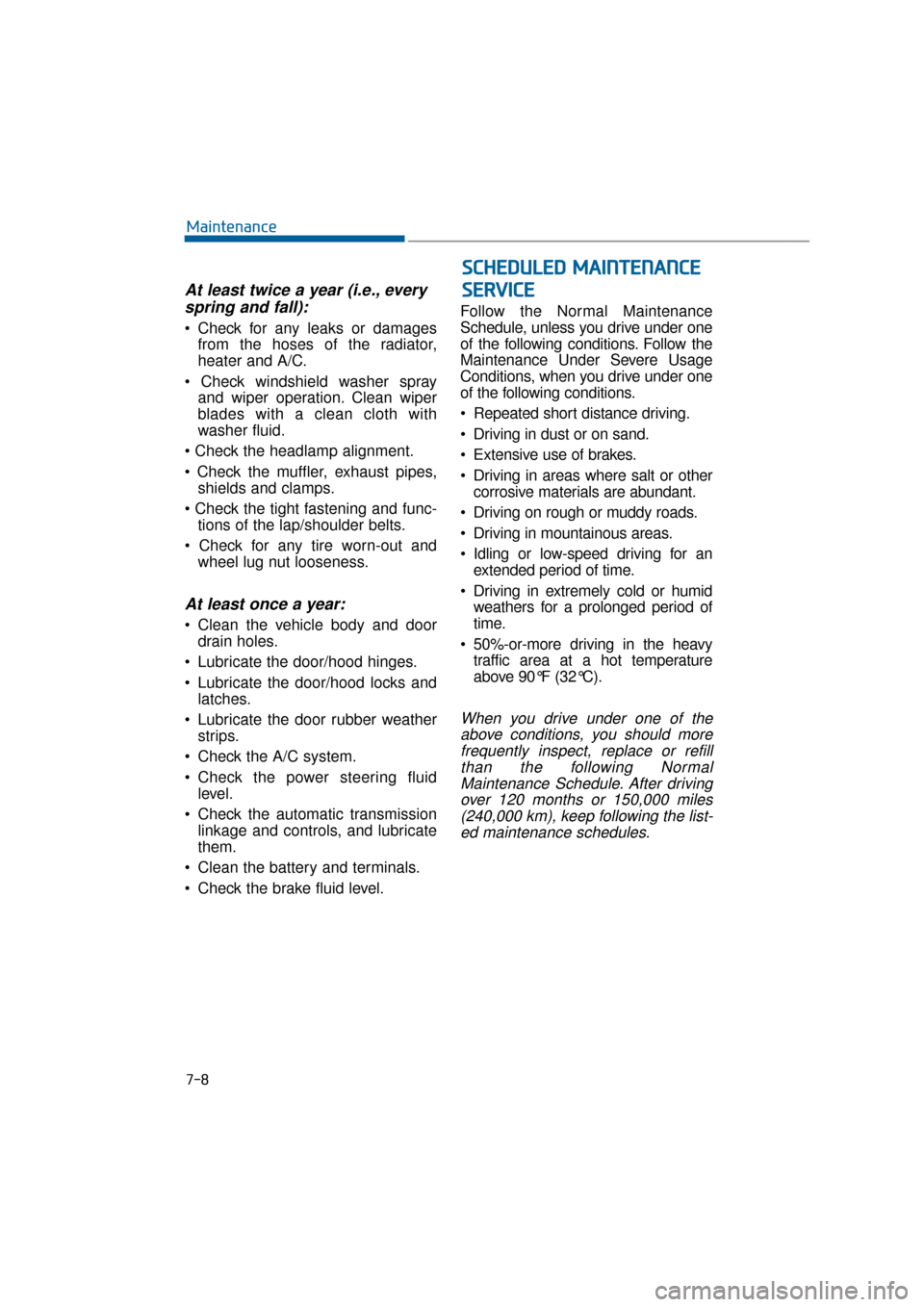
At least twice a year (i.e., everyspring and fall):
Check for any leaks or damages
from the hoses of the radiator,
heater and A/C.
and wiper operation. Clean wiper
blades with a clean cloth with
washer fluid.
shields and clamps.
tions of the lap/shoulder belts.
wheel lug nut looseness.
At least once a year:
Clean the vehicle body and doordrain holes.
Lubricate the door/hood hinges.
Lubricate the door/hood locks and latches.
Lubricate the door rubber weather strips.
Check the A/C system.
Check the power steering fluid level.
Check the automatic transmission linkage and controls, and lubricate
them.
Clean the battery and terminals.
Check the brake fluid level. Follow the Normal Maintenance
Schedule, unless you drive under one
of the following conditions. Follow the
Maintenance Under Severe Usage
Conditions, when you drive under one
of the following conditions.
Repeated short distance driving.
Driving in dust or on sand.
Extensive use of brakes.
Driving in areas where salt or other
corrosive materials are abundant.
Driving on rough or muddy roads.
Driving in mountainous areas.
Idling or low-speed driving for an extended period of time.
Driving in extremely cold or humid weathers for a prolonged period of
time.
50%-or-more driving in the heavy traffic area at a hot temperature
above 90°F (32°C).
When you drive under one of theabove conditions, you should morefrequently inspect, replace or refillthan the following NormalMaintenance Schedule. After drivingover 120 months or 150,000 miles(240,000 km), keep following the list-ed maintenance schedules.
7-8
Maintenance
S S C
C H
H E
ED
D U
U L
LE
E D
D
M
M A
AI
IN
N T
TE
EN
N A
AN
N C
CE
E
S
S E
E R
R V
V I
IC
C E
E
Page 380 of 477
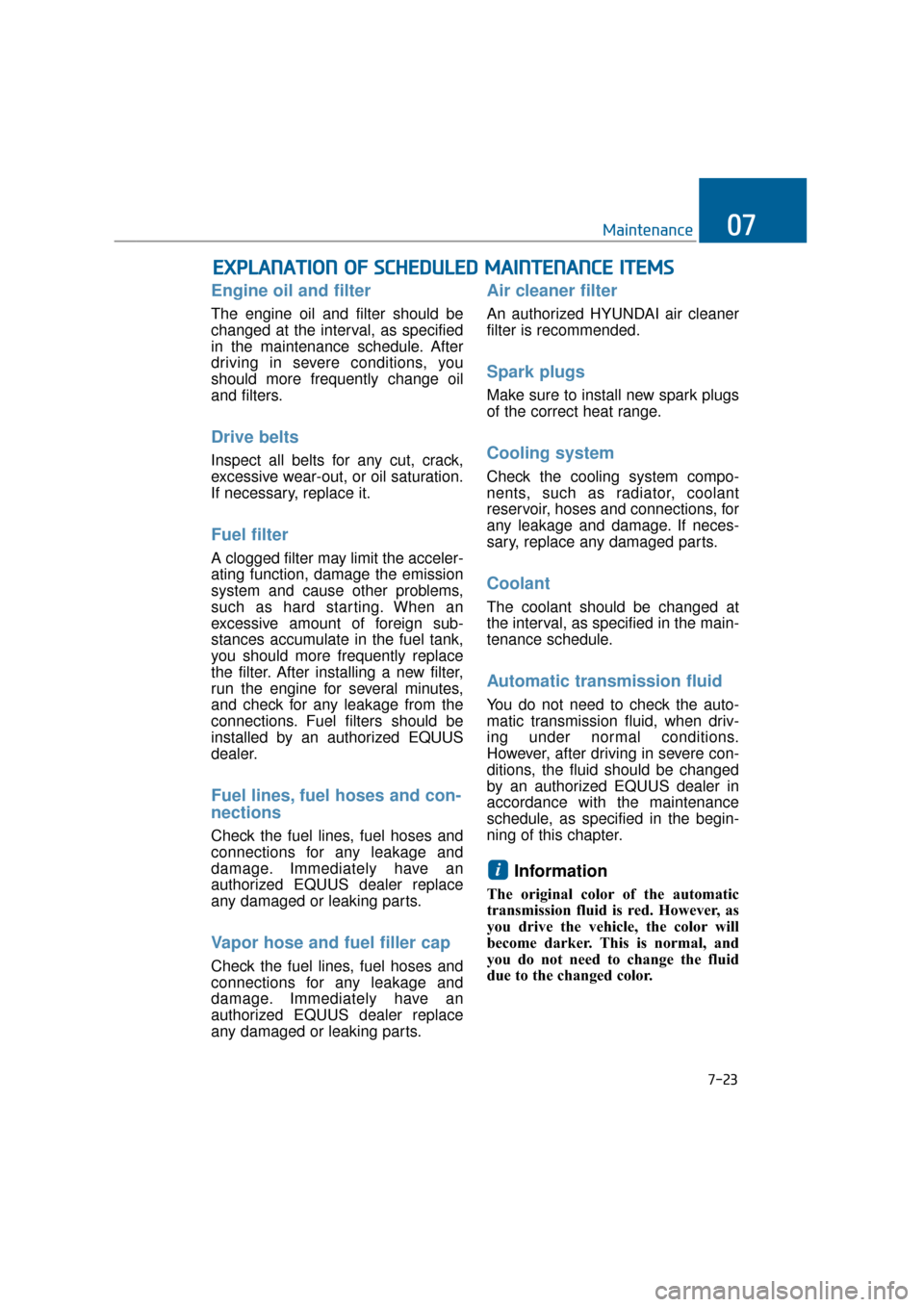
7-23
Maintenance07
E
EX
X P
PL
LA
A N
N A
AT
TI
IO
O N
N
O
O F
F
S
S C
C H
H E
ED
D U
U L
LE
E D
D
M
M A
AI
IN
N T
TE
EN
N A
AN
N C
CE
E
I
IT
T E
EM
M S
S
Engine oil and filter
The engine oil and filter should be
changed at the interval, as specified
in the maintenance schedule. After
driving in severe conditions, you
should more frequently change oil
and filters.
Drive belts
Inspect all belts for any cut, crack,
excessive wear-out, or oil saturation.
If necessary, replace it.
Fuel filter
A clogged filter may limit the acceler-
ating function, damage the emission
system and cause other problems,
such as hard starting. When an
excessive amount of foreign sub-
stances accumulate in the fuel tank,
you should more frequently replace
the filter. After installing a new filter,
run the engine for several minutes,
and check for any leakage from the
connections. Fuel filters should be
installed by an authorized EQUUS
dealer.
Fuel lines, fuel hoses and con-
nections
Check the fuel lines, fuel hoses and
connections for any leakage and
damage. Immediately have an
authorized EQUUS dealer replace
any damaged or leaking parts.
Vapor hose and fuel filler cap
Check the fuel lines, fuel hoses and
connections for any leakage and
damage. Immediately have an
authorized EQUUS dealer replace
any damaged or leaking parts.
Air cleaner filter
An authorized HYUNDAI air cleaner
filter is recommended.
Spark plugs
Make sure to install new spark plugs
of the correct heat range.
Cooling system
Check the cooling system compo-
nents, such as radiator, coolant
reservoir, hoses and connections, for
any leakage and damage. If neces-
sary, replace any damaged parts.
Coolant
The coolant should be changed at
the interval, as specified in the main-
tenance schedule.
Automatic transmission fluid
You do not need to check the auto-
matic transmission fluid, when driv-
ing under normal conditions.
However, after driving in severe con-
ditions, the fluid should be changed
by an authorized EQUUS dealer in
accordance with the maintenance
schedule, as specified in the begin-
ning of this chapter.
Information
The original color of the automatic
transmission fluid is red. However, as
you drive the vehicle, the color will
become darker. This is normal, and
you do not need to change the fluid
due to the changed color.
i
Page 382 of 477
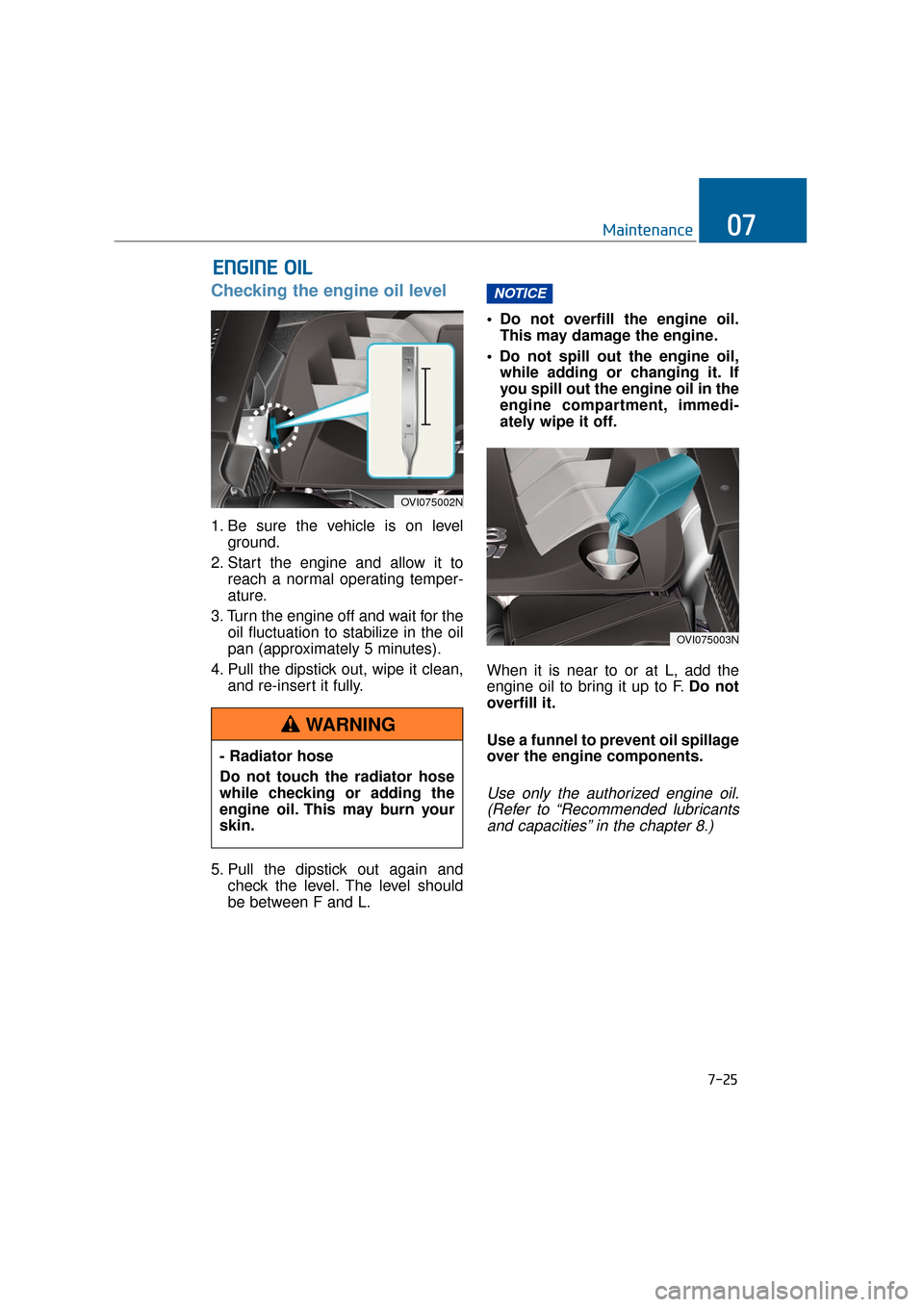
7-25
Maintenance07
Checking the engine oil level
1. Be sure the vehicle is on levelground.
2. Start the engine and allow it to reach a normal operating temper-
ature.
3. Turn the engine off and wait for the oil fluctuation to stabilize in the oil
pan (approximately 5 minutes).
4. Pull the dipstick out, wipe it clean, and re-insert it fully.
5. Pull the dipstick out again and check the level. The level should
be between F and L. Do not overfill the engine oil.
This may damage the engine.
while adding or changing it. If
you spill out the engine oil in the
engine compartment, immedi-
ately wipe it off.
When it is near to or at L, add the
engine oil to bring it up to F. Do not
overfill it.
Use a funnel to prevent oil spillage
over the engine components.
Use only the authorized engine oil. (Refer to “Recommended lubricantsand capacities” in the chapter 8.)
NOTICE
E E N
N G
GI
IN
N E
E
O
O I
IL
L
OVI075002N
- Radiator hose
Do not touch the radiator hose
while checking or adding the
engine oil. This may burn your
skin.
WARNING
OVI075003N
Page 384 of 477
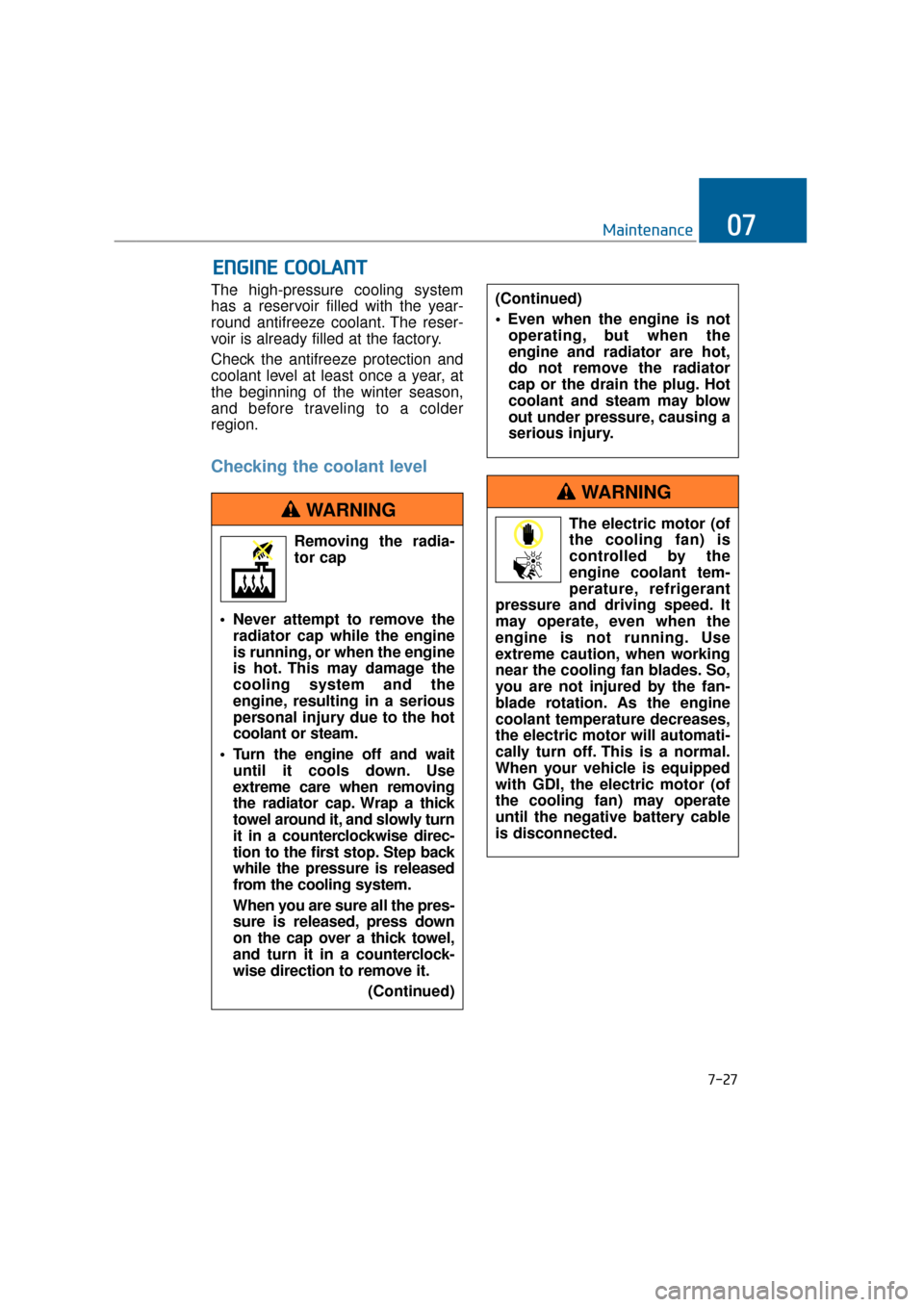
7-27
Maintenance07
The high-pressure cooling system
has a reservoir filled with the year-
round antifreeze coolant. The reser-
voir is already filled at the factory.
Check the antifreeze protection and
coolant level at least once a year, at
the beginning of the winter season,
and before traveling to a colder
region.
Checking the coolant level
E EN
N G
GI
IN
N E
E
C
C O
O O
OL
LA
A N
N T
T
(Continued)
operating, but when the
engine and radiator are hot,
do not remove the radiator
cap or the drain the plug. Hot
coolant and steam may blow
out under pressure, causing a
serious injury.
The electric motor (of
the cooling fan) is
controlled by the
engine coolant tem-
perature, refrigerant
pressure and driving speed. It
may operate, even when the
engine is not running. Use
extreme caution, when working
near the cooling fan blades. So,
you are not injured by the fan-
blade rotation. As the engine
coolant temperature decreases,
the electric motor will automati-
cally turn off. This is a normal.
When your vehicle is equipped
with GDI, the electric motor (of
the cooling fan) may operate
until the negative battery cable
is disconnected.
WARNING
Removing the radia-
tor cap
Never attempt to remove the radiator cap while the engine
is running, or when the engine
is hot. This may damage the
cooling system and the
engine, resulting in a serious
personal injury due to the hot
coolant or steam.
Turn the engine off and wait until it cools down. Use
extreme care when removing
the radiator cap. Wrap a thick
towel around it, and slowly turn
it in a counterclockwise direc-
tion to the first stop. Step back
while the pressure is released
from the cooling system.
When you are sure all the pres-
sure is released, press down
on the cap over a thick towel,
and turn it in a counterclock-
wise direction to remove it.
(Continued)
WARNING
Page 386 of 477
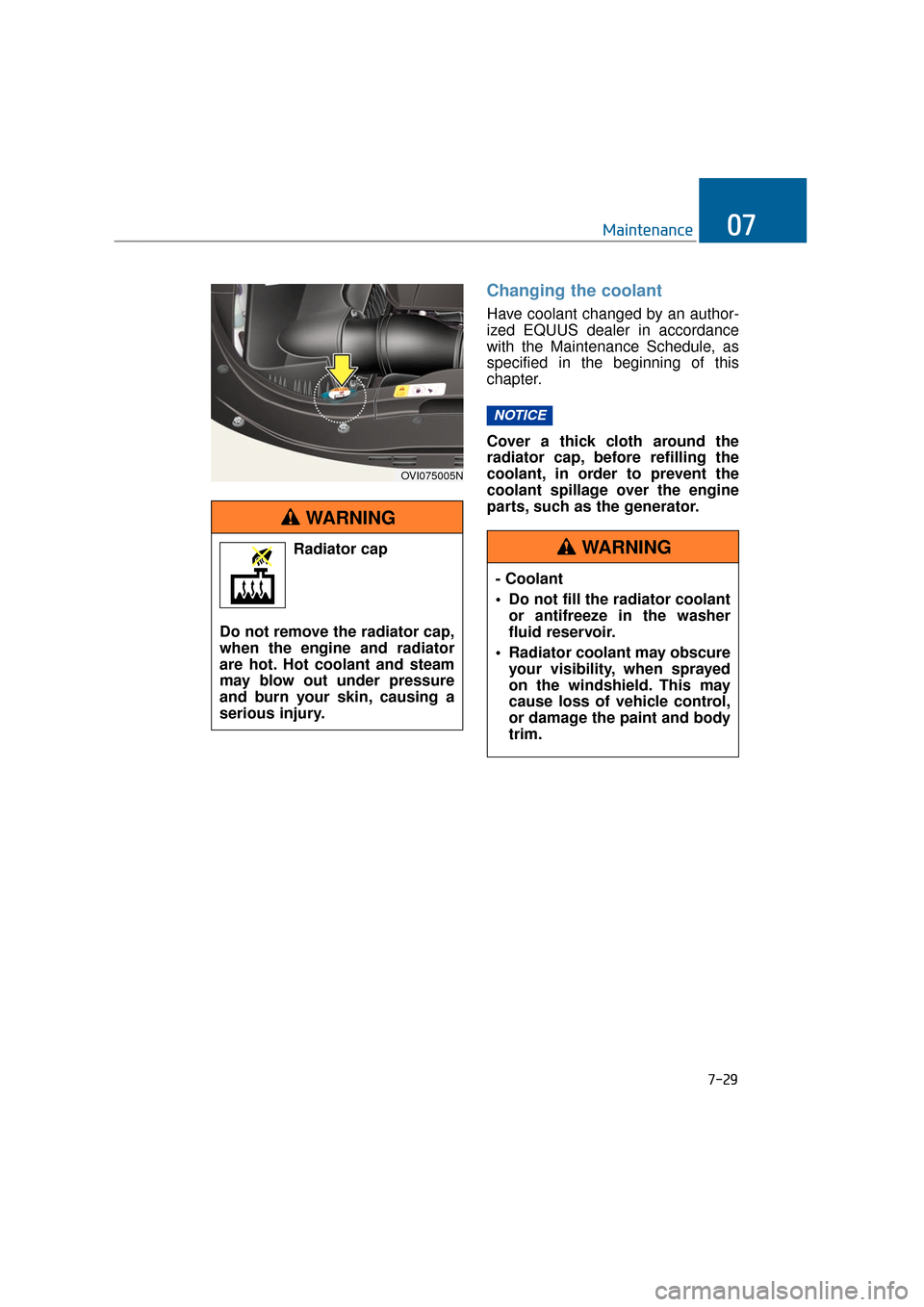
7-29
Maintenance07
Changing the coolant
Have coolant changed by an author-
ized EQUUS dealer in accordance
with the Maintenance Schedule, as
specified in the beginning of this
chapter.
Cover a thick cloth around the
radiator cap, before refilling the
coolant, in order to prevent the
coolant spillage over the engine
parts, such as the generator.
NOTICE
OVI075005N
Radiator cap
Do not remove the radiator cap,
when the engine and radiator
are hot. Hot coolant and steam
may blow out under pressure
and burn your skin, causing a
serious injury.
WARNING
- Coolant
Do not fill the radiator coolant or antifreeze in the washer
fluid reservoir.
Radiator coolant may obscure your visibility, when sprayed
on the windshield. This may
cause loss of vehicle control,
or damage the paint and body
trim.
WARNING